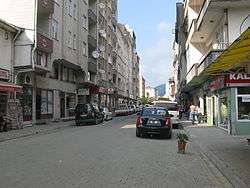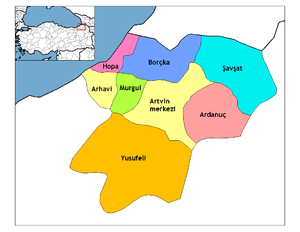Hopa
Hopa is a city and district of Artvin Province in northeast Turkey. It is located on the eastern Turkish Black Sea coast about 67 km (42 mi) from the city of Artvin and 18 kilometres from the border with Georgia.
Hopa | |
|---|---|
 Downtown Hopa | |
 Hopa | |
| Coordinates: 41°23′25″N 41°25′10″E | |
| Country | Turkey |
| Province | Artvin |
| Government | |
| • Mayor | Nedim Cihan (AKP) |
| • Kaymakam | Mustafa Erkayıran |
| Area | |
| • District | 212.55 km2 (82.07 sq mi) |
| Population (2012)[2] | |
| • Urban | 18,296 |
| • District | 33,129 |
| • District density | 160/km2 (400/sq mi) |
| Post code | 08600 |
| Climate | Cfa |
| Website | www.hopa.bel.tr |
Geography
Hopa is on the Black Sea Coast 65 km from Artvin and 18 km from the Sarp border crossing (into Sarpi) on the Georgian border. The land climbs sharply from 10m above sea level in the coastal areas up into the Sultan Selim Mountains, the hillsides are well watered and green with alder, chestnuts, hornbeams and other deciduous trees. The highest point is Mt Yavuz Sultan Selim at 1513m. The climate is mild and wet, although only July and August are warm enough to be called summer. There is annual snowfall in winter.
History
The area was part of the kingdom of Colchis but was always vulnerable to invasions, first the Scythians from across the Caucasus, then the Muslim armies led by Habib, son of Caliph Uthman who controlled the area from 853 AD to 1023 when it was conquered by the Byzantines from the Sac Emirate allied to the Abbasids. The Seljuk Turks led by Alp Arslan conquered the area in 1064. With the collapse of the Seljuks, the Artvin area came under the control of the Ildeniz, one of the Anatolian Turkish beyliks[3][4][5][6][7][8][9]
Ottoman Sultan Selim I brought it into the Ottoman Empire during his campaign against the Crimea that took place in 1490–1512. Lala Mustafa Pasha made it part of the Çıldır Eyalet formed in 1578. The area was captured by Russia following the Russo-Turkish War (1877-1878) and many people of Hopa moved westwards away from the Russian-controlled zone. Hopa was returned as part of the Brest Litovsk Agreement in 1918 and formally joined Turkey on 14 March 1921. The Sarp border gate was opened on 31 August 1988 with the "International Road Transport Agreement" between Soviet Union and Turkey and gave a big boost to Hopa in trade and tourism.
There is currently a high rate of cancer in Hopa, attributed to fall-out from the Chernobyl disaster, across the Black Sea from here.[10] Between 2001 and 2004, cancer cases sharply increased in the Black Sea region, especially in Hopa, with 47.9% of all deaths during this time being due to cancer.[11]
Economy
The economy is based on trade, fishing and agriculture, mostly tea, nuts (especially Hazelnuts) and kiwifruit. There are two tea factories, the Black Sea Copper Works, a Thermal Power Plant, the Hopa port and the Hopa Vocational School. It has direct bus connections to Trabzon, Rize, Artvin, Ardahan, Kars, Erzurum and Sarp which go on to Georgia. The Sarp border gate was opened on 31 August 1988 with the "International Road Transport Agreement" between Soviet Union and Turkey and gave a big boost to Hopa in trade and tourism. The Hopa Port is managed by a privately owned company Hopa Limani and is active in international trade.[12]
Well-known citizens
- Adem Büyük (born 1987), footballer
- Kazım Koyuncu (1971–2005), rock guitarist and singer
- Tolga Zengin (born 1983), footballer
- Levent Yazıcı (born 1970), photographer, Musician
- Mehmet Naci Dedeal (born 1959), artistic director, animator
- Mustafa Topaloğlu (born 1957), singer and political activist
- Cemil Aksu (born 1977), Hamshen Armenian political and social activist
Climate
This area is characterized by equable climates with few extremes of temperature and ample precipitation in all months. Hopa has a humid subtropical climate (Köppen: Cfa).
| Climate data for Hopa | |||||||||||||
|---|---|---|---|---|---|---|---|---|---|---|---|---|---|
| Month | Jan | Feb | Mar | Apr | May | Jun | Jul | Aug | Sep | Oct | Nov | Dec | Year |
| Daily mean °C (°F) | 7.2 (45.0) |
7.5 (45.5) |
8.8 (47.8) |
12.2 (54.0) |
15.7 (60.3) |
19.5 (67.1) |
21.9 (71.4) |
22.3 (72.1) |
19.8 (67.6) |
16.0 (60.8) |
12.5 (54.5) |
9.2 (48.6) |
14.4 (57.9) |
| Average precipitation mm (inches) | 207 (8.1) |
152 (6.0) |
130 (5.1) |
100 (3.9) |
82 (3.2) |
148 (5.8) |
131 (5.2) |
173 (6.8) |
216 (8.5) |
264 (10.4) |
236 (9.3) |
248 (9.8) |
2,087 (82.1) |
| Source: Climate-Data.org[13] | |||||||||||||
See also
References
- "Area of regions (including lakes), km²". Regional Statistics Database. Turkish Statistical Institute. 2002. Retrieved 2013-03-05.
- "Population of province/district centers and towns/villages by districts - 2012". Address Based Population Registration System (ABPRS) Database. Turkish Statistical Institute. Retrieved 2013-02-27.
- The Turks: Middle ages, Hasan Celāl Güzel, Cem Oğuz, Osman Karatay, 2002
- Les Origines de l'Empire ottoman, Mehmet Fuat Köprülü, Gary Leiser, 1992, page 82
- European and Islamic trade in the early Ottoman state: the merchants of Genoa and Turkey, Kate Fleet, 1999, page 49
- Turkey, Verity Campbell, 2007, page 35
- Turkey, James Bainbridge, 2009, page 33
- Eastern Turkey: The Bradt Travel Guide, Diana Darke, 2011, page 77
- The Turks: Early ages, Hasan Celāl Güzel, Cem Oğuz, Osman Karatay, 2002
- Çernobil sonrası Türkiye’de kanser
- http://www.sundayszaman.com/sunday/detaylar.do?load=detay&link=208417
- Hopa Ekonomisi Archived 2011-10-01 at the Wayback Machine
- "Climate:Hopa". Climate-Data.org. Retrieved 17 March 2014.
External links
- Governor's Office
- the Municipality
- (in Turkish) Photo and Art website
- (in Turkish) Photo and mountaineering
- local information
- (in Turkish) photos of Hopa in local news website
- Hopa Port's web site
- Hopa Otelleri
